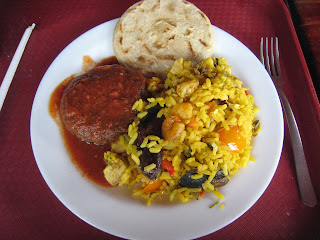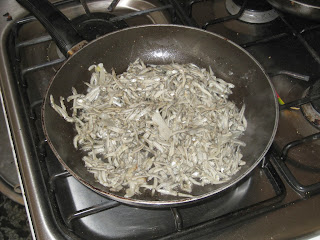Buen provecho! Bon appétit! Happy eating!
Pupusas: These are corn tortillas stuffed with one or more of the following:
refried beans, cheese (a soft Salvadoran cheese), chicharrón (cooked pork meat), squash
(usually guisquil/ayote), or loroco (edible flowers). Pupusas can be bought nearly everywhere
in El Salvador. There are even restaurants dedicated to this hearty treat,
aptly named pupuserías.
Pupusas are served with a pickled cabbage salad (curtido) and fresh tomato
sauce.
Tortillas: These are like circular flatbreads made from corn or wheat originally
made by Mesoamerican peoples. The tortillas in El Salvador are thick and made
from corn. Tortillas are usually consumed during lunch and dinner.
Beans (frijoles): Beans (usually red beans) are cooked in
many different ways. They may be whole, mashed, or pureed and served hot or
cold. They are often eaten for breakfast, lunch, and dinner.
Rice (arroz): A popular grain known all around the world,
rice is also common in El Salvador. This grain is second only to maize (corn)
in worldwide production.
Casamiento: In Spanish “casamiento” means marriage. In El Salvador, casamiento is
a mixture of rice and beans and it is delicious!
Tamales: Pockets of corn dough (like a corn dumpling) stuffed with meat,
veggies, or sweet corn and cooked in banana leaves or corn husks. They can be
served hot or cold.
Plantains (plátanos): Though similar to
bananas, plantains are usually fried or boiled. They are often served with a
variety of accompaniments such as beans, sour cream, cheese, and eggs.
Chicken (pollo): Farm fresh chicken served fried, grilled,
and in soup.
Seafood (mariscos): Fish, shrimp, oysters, lobster, and
calamari can all be found in El Salvador. White fish and shrimp are the more
common types of seafood served at the Pastoral House.
Ceviche: Raw fish cured in lime juice often mixed
with cilantro, green peppers, salt, and onions. I have never had this at the
Pastoral House but you can get it at the beach.
Riguas: These
are made from elote (sweet corn). After the sweet corn has been removed from
the cob it needs to be put through a grinder or into a blender. From there it’s
fried up on a griddle or something in the like. They’re basically small, sweet
corn fried pancakes. Kind of like potato pancakes.
Panes
rellenos: Big
stuffed sandwiches filled with roasted chicken or turkey and vegetables.
Cheese (queso): There are several types of cheese found in
El Salvador. The most common type of cheese is hard, crumbly, white, and salty.
It’s eaten with beans, tortillas, bread, and by itself.
Eggs (huevos): Farm fresh eggs served fried, scrambled,
hard-boiled, and more. They are delicious fried inside of a tortilla.
Guisquil/Chayote: This vegetable is a member of the gourd
family and can be eaten in many forms- boiled, mashed, fried, baked, or raw.
Yucca: A white, starchy
vegetable (root) originally from South America. Yucca can be served boiled, fried,
and are sometimes fried up like potato chips.
Fruit (fruta): Pineapples, mangos, guava, coconuts, watermelons,
cantaloupes, bananas, limes, oranges, passion fruit, and other exotic fruits
are common in El Salvador.
Vegetables (verduras): Avocados, lettuce, carrots, potatoes,
tomatoes, broccoli, green beans, onions, and squash can be found in El Salvador.
Pan dulce: Spanish for sweet bread, these bread and sometimes pastry-like treats
come in a variety of shapes, sizes, and flavors.
Drinks
Horchata: A drink made
from a mix of spices, rice, and
morro seeds.
Ensalada: A thick drinkable blend of finely chopped
tropical fruits and juices such as pineapple apples, marañon, and
watermelon.
Atol: Atol is a thick, masa based drink. It’s made of corn flour, water,
and unrefined sugar. A Salvadoran variety of atol is called atol chuco, which
means “dirty” atol because of its darker color.
Tamarind: A
unique drink with a tangy, earthy flavor made from tamarind fruit and pulp
found inside the pods.
Jamaica: Basically
a cold drink made from hibiscus flowers with a little sugar added.
Atol chucho
Tortillas
Corn
Freshly picked beans
Dried beans
Spices
Corn cooking
Making pupusas
Making riguas
The market
Fresh fruit
Assortment of fruit
Guava, passionfruit- 2, zapote, starfruit, rambutan
Assortment of fruit #2
Rambutan, passion fruit- 2, Nance, Marañon
Mamon
Nances
Mamey
Passion fruit
Coconuts
More fruit
Pineapples and bananas
Limes
Woman with jocotes
Anona
Papaya
Marañones
Green mangos
Giant mangos
Yummy mangos
Mmmmm mangos
Ensalada fruit drink
Salvadoran hamburger
Bananas
Add some panela (like brown sugar)
= Deliciousness
Panela
Ayote squash
Cooked with panela
...equals deliciousness!
Casamiento, tortillas with cheese,
empanadas (smashed and fried plantains filled with cream)
Breakfast: plantains, beans, egg
Same breakfast, cooked differently
Paella, hamburger, tortilla
Tamale, casamiento, French fries, tortillas with cheese
PUPUSAS!!!
Tacos
Tortilla with an egg
(One of my favorites!)
Chicken, veggies, rice, tortillas
Standard lunch for me
Same thing, only with veggies in a soup
Same thing, with everything in the soup
Salvadoran enchiladas with French fries
Another favorite
Chicken, rice, and veggies
Iguana (I tried it once)
Riguas
Dried and fried fish
(Did not like this)
Fish from the market
Crabs
Cooked fish
A near-the-beach specialty: calamari
Another near the beach and nice restaurant specialty:
Stuffed lobster
Shrimp!
Nuegados (fried yucca with syrup)
Homemade ice cream
Fresh honey
Pan dulce
Candy!!
Chocolate covered bananas
Cocoa beans
Tamales
A different kind of tamale
Loroco flower (used in pupusas)
Guisquil (a veggie)
Avocados!!
I could eat these daily
Iceberg lettuce salad
Not one of my favorites







































































